
Skins for DOTA: How to Find, Value, and Enjoy Cosmetic Items in Dota 2
If you play Dota 2, you know the difference a good CS2 Skins—or a complete set—can make. It’s not about power; it’s about personality. Skins let you personalize heroes, couriers, wards, announcer packs and even the game’s user interface. They turn familiar heroes into new characters, give spells a flashier palette, and make the loading screen worth a second look. This article walks through what skins are, how they’re made and distributed, where to buy or trade them, and how to think about their value so you can build a collection that feels right for you.
We’ll cover the systems Valve uses, the community tools that matter, the rare types collectors chase, and practical tips to avoid scams or bad purchases. Expect concrete steps, examples of popular cosmetic lines, and ideas on how to use items to enhance your play without losing sight of the social side of the market. Whether you’re just curious or you want to become a savvy trader, this is the practical guide to skins for DOTA you didn’t know you needed.
What Are Dota 2 Skins and How Do They Work?
In Dota 2, “skins” is a casual term for cosmetic items: anything that changes appearance without altering gameplay mechanics. These include hero wearable items (hats, weapons, capes), complete sets, couriers, wards, HUDs, announcer packs, loading screens, and special effects like particle overlays. Valve distributes many items through Treasure boxes, the Battle Pass, the in-game store, and the Steam Community Market. The community contributes through the Steam Workshop; if an item is accepted by Valve, it becomes part of the official economy.
Cosmetics are purely visual. They don’t change stats, hitboxes, or abilities. What they do change is presence: an Arcana can redraw a hero’s silhouette and animations, making your hero feel new. Immortal and Arcana-tier items come with unique particles or animations and are usually more desirable and rare.
Common Item Types and Rarities
Dota 2 follows a rarity and item-type system that affects drop rates and perceived value. Knowing the terminology will help when you browse the market or trade with others.
| Rarity | Typical Features | How Obtained |
|---|---|---|
| Common/Uncommon | Simple wearable items, minor visual changes | Treasure drops, Workshop |
| Rare/Mythical | Sets, better textures, sometimes alternative styles | Treasure boxes, Battle Pass |
| Immortal | New particles, model parts, high demand | Special treasures, drops during events |
| Arcana | Full re-skin, new animations, voice effects | Direct sale, Battle Pass rewards |
| Ancient/Exalted | Very rare, usually tournament or one-off promotional | Tournament drops, special promotions |
Where Skins Come From: Valve, Workshop, and Tournaments
Items arrive in the ecosystem in a few ways. Valve curates and sells items itself, especially Battle Pass or event-linked cosmetics. The Steam Workshop lets creators submit designs; Valve sometimes accepts those for sale. Tournament organizers and teams can release tournament items—those are the “tournament” or “autographed” variants that carry player/team signatures and can suddenly spike in value during big events.
Major yearly events like The International tend to generate special treasures. Battle Passes usually bring new mechanics: item styles, sockets for Gems (inscribed stats, kill counters), and limited-time treasures. Keep an eye on these releases; the first time an Arcana drops or a courier debuts, its price and demand can swing wildly.
How Items Drop and What “Treasure” Means
“Treasure” is how Valve packages randomized rewards. Buying or receiving a treasure gives you a chance at certain items listed in that treasure—and a small chance at rarer tiers. Some treasures also include “uncommon” to “immortal” items at set probabilities. Battle Pass owners may also receive free treasure drops through leveling. Remember: randomized boxes are chance-based. Expect variance and don’t chase every rare drop emotionally.
Buying, Selling, and Trading: Practical Steps
If you want to acquire skins, you have three main paths: buy from the Steam Community Market, trade with other players, or get lucky through drops and Battle Pass rewards. Each has its trade-offs.
How to Buy Safely
- Use the Steam Community Market for straightforward purchases—the price includes Steam’s fee and the transaction is secure.
- Check recent sale history to understand price trends. Look at multiple listings before buying.
- If you use third-party marketplaces, verify reputation, read reviews, and avoid sites that ask for your Steam password or require non-Steam payment links directly to strangers.
- Always enable Steam Guard and be aware of trade holds if you recently changed passwords or authentication settings.
Trading Tips
- Use Steam’s built-in trade window so there’s a record of exchanged items and offers.
- Consider using middleman services only from well-known, community-trusted sources; most disputes are avoided by reading community forums first.
- When trading for value, compare recent market prices rather than storefront “asking” prices.
- Look for bundles or set pieces—sometimes a full set costs less per-item than buying pieces individually.
How to Evaluate Value: A Practical Framework
Item value isn’t only rarity. It’s a combination of rarity, demand (popularity of the hero), condition (some items have alternate styles), provenance (tournament autographs), and supply (was it limited-time?). Build a simple checklist before buying:
- Is the hero popular in the current meta? Popular heroes often carry demand.
- Is the item unique—Arcana, Immortal—or just one of many variants?
- Does the item have gems, autographs, or special particle effects?
- What’s the recent sales history for the exact item (not just similar items)?

Also remember that cosmetics are entertainment purchases. Don’t over-leverage real money for speculative flips unless you accept the risk of loss. The market can be volatile—supply inflates with new treasures and player interest declines after a season.
Popular Skin Categories Worth Knowing
Some item categories consistently hold attention from collectors and players. Here are the ones you’ll see most often and why they matter.
| Category | Why It Matters | Example |
|---|---|---|
| Arcana | Re-skins with new animations; often the most coveted | Invoker Arcana, Phantom Assassin Arcana |
| Immortal | Particle effects and model parts that change spells | Juggernaut Immortal blade, Lina Immortal staff |
| Couriers | Collectible and often highly decorative; can become expensive | Vintage or unusual couriers from early tournaments |
| Announcers/HUDs | Personalizes the interface and voice lines; unique feel | VIP tournament announcer |
Examples of Popular Hero Skins
- Phantom Assassin: Arcana items frequently top market attention because of the hero’s popularity in pubs and ranked play.
- Pudge: Odd skins and couriers for Pudge become conversation pieces—great for players who enjoy a theatrical presence.
- Juggernaut and Lina: Classic heroes that receive Immortal drops which can spike in value during events.
Customization and In-Game Use
Equipping a cosmetic is simple via the Heroes page in your Dota 2 client. You can equip full sets or mix-and-match items for a custom look. Some items have alternate styles unlocked by crafting or by earning levels in a Battle Pass. Gems and socketed items allow you to track kills, wins, or other stats. They don’t change gameplay but they can be enjoyable progress markers.
Remember: flashy cosmetics can make you more visible in team fights. If you want to be subtle, choose smaller items and avoid particle-heavy Immortals when playing stealth or support roles.
Scams, Safety, and Marketplace Ethics
Scams remain the most frequent source of regret for players. Most scams rely on urgency, impersonation, or off-platform communication. Always verify links and never give your Steam password. Use the Steam trade window and check profile URLs manually if someone claims to be a known trader. Keep two-factor authentication on. If a deal seems too good to be true, it usually is.
Also, don’t participate in gambling or skin betting sites. Those markets are unregulated and frequently target inexperienced players. The entertainment value of a cosmetic isn’t worth legal or financial risk.
Conclusion
Skins for Dota 2 are a creative layer on top of the game CS2run—an opportunity to express yourself, support creators and tournaments, and sometimes to invest in items you love. Learn the rarity system, use safe trading practices, watch price history, and focus on items that bring you joy in-game rather than chasing every market swing. With a little knowledge and caution, collecting cosmetics becomes part of the fun of Dota rather than a gamble. Enjoy curating your heroes, and let the visuals reflect your playstyle and personality.

